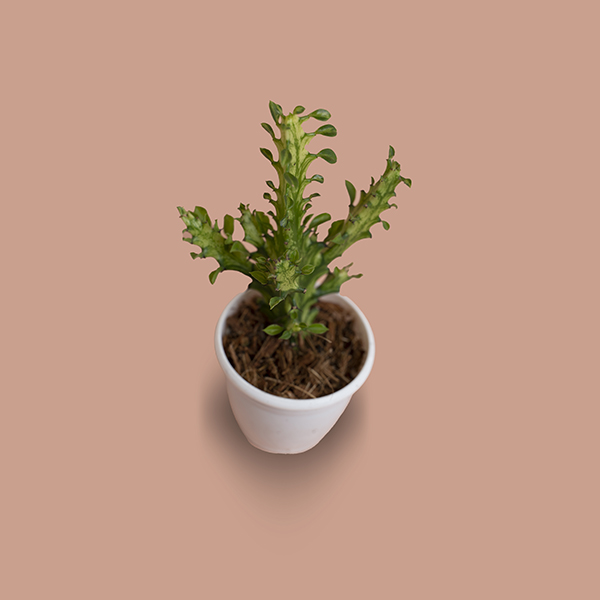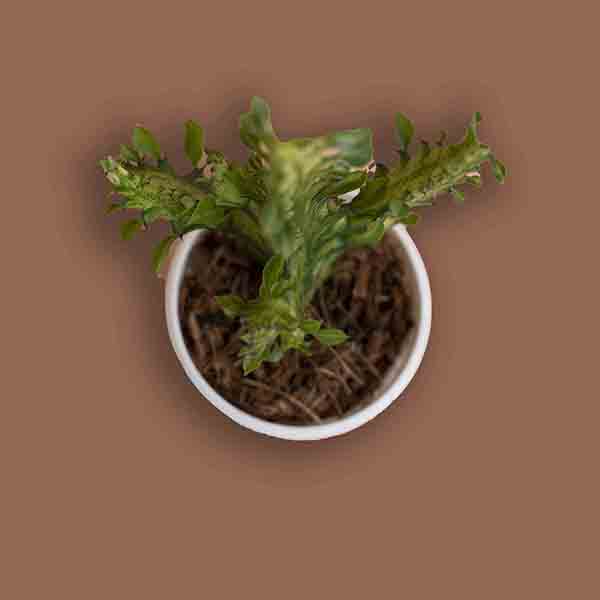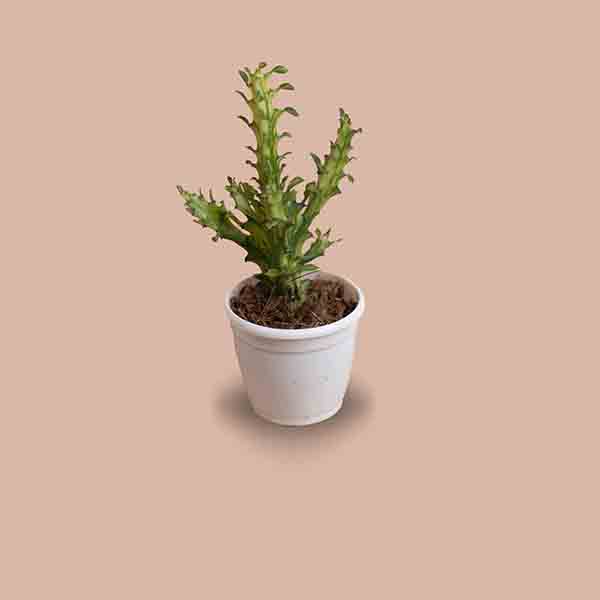The African milk tree (Euphorbia trigona) is native to Central Africa. It is often grown as a hedge there, useful for its rapid and enthusiastic growth, though its roots are not invasive. Though it looks a lot like a cactus, it is actually a succulent plant. It has many folk names, including candelabra cactus, cathedral cactus, friendship cactus, good luck plant. or good luck cactus (the good luck attribution is probably due to how quickly it grows, and how easily it propagates). It stays lush and green throughout its growing season, and new growth has a lighter green color than the base plant. The Rubra or Royal Red cultivar is very popular for its dramatic coloring: It takes on bright red accents later in the season.
The African milk tree is long-lived and can grow very vigorously, 1 to 2 feet a year in height, to a total of 8 feet tall. If grown indoors, it will grow to about half that height. They’re grown by many gardeners in states with arid climates where the temperatures at night don’t go below 50 degrees Fahrenheit, such as parts of Texas, Arkansas, and Arizona.
| Botanical Name | Euphorbia trigona |
| Common Name | African milk tree, African milk bush |
| Plant Type | Succulent |
| Mature Size | 6-8 ft. |
| Sun Exposure | Indirect sun to partial shade |
| Soil Type | Medium rich, well-drained |
| Soil pH | 6.1 to 7.8 (mildly acidic to mildly alkaline) |
| Bloom Time | Spring, summer |
| Flower Color | White (outdoors only) |
| Hardiness Zones | 9b-11 (USDA) |
| Native Areas | Central Africa |
| Toxicity | Toxic to humans and pets |
African Milk Tree Care
The African milk tree is popular as a decorative landscape or container plant throughout South America and in the Mediterranean regions of Europe. Its dramatic size makes it a sought-after plant for enthusiasts, and they may require training through pruning and staking. African milk tree is fairly easy to propagate also, similar to a cactus, where one simply breaks off one of the “arms” and roots in potting medium.
The African milk tree is also very drought-tolerant and useful for xeriscaping. It’s hardy in Zones 9b through 11 in the United States, and can probably survive to Zone 8 with winter protection. Because they grow so tall but have a comparatively small root system, they can topple over, so keep them pruned and use staking when needed.
Light
This succulent likes indirect but bright sunlight. A southern-facing window will work well for it indoors or an outdoor spot with partial sun. Full sun is suitable as long as the summers are not too consistently hot. Extra watering may be needed to offset too much bright sunlight.
Soil
This plant is not too fussy about soil but good drainage is essential. Heavy clay soils may hamper growth, and impede drainage. Since this plant is a good choice for xeriscaping, sandy soils are a good fit, and sandy loam probably works best of all.
Water
Being a succulent, the African milk tree doesn’t need much water. If there is a very bad drought, consider supplemental watering at the roots. But otherwise normal rainfall should be sufficient. Indoor specimens should be watered moderately once a week. Let the soil dry out between each watering to mimic its natural habitat.
Temperature and Humidity
This drought-tolerant plant enjoys a dry or arid climate and can tolerate fairly hot temperatures. If grown in a place with very hot summers, the plant should be located in a spot with indirect sunlight or partial shade, to avoid overheating. This plant doesn’t need any extra humidity, and growing it in an environment that is too humid may cause issues such as fungus or pests.
Fertilizer
During the plant’s growing season in the spring and summer, treat it to water-soluble fertilizer once a month.
Pruning
African milk trees don’t always require pruning. But because they grow so tall, but have a comparatively small, shallow root system, it’s not unusual for them to become top-heavy or to even topple over, so pruning may be necessary. Use a sharp and sterilized knife to prune stems. The cut will dry over and create a callus on its own. Make sure the plant is balanced on both sides because a shallow root system can’t always hold down a plant that’s too heavy on one side.
Propagating African Milk Tree
The African milk tree propagates easily. You only need a pair of scissors or hand pruners and a container with potting medium. Use proper protective gear when propagating, like heavy gloves, and wash immediately if you get any of the milky sap on your skin. Here are the easy steps:
- Cut one of the “arms” off with sharp shears or scissors at its base.
- Rinse the arm with running cold water until it stops oozing.
- Let the arm sit in a dry spot on a paper towel and out of direct sun for five to seven days so the cut tip can callus over (this prevents rotting). (Note: Many growers bypass the callus stage and put the cutting directly into soil as soon as it is cut. Growth should occur within three weeks with this method.)
- Once the callus has formed, you can plant it in a small pot (about 4-inches wide).
- Plant the cutting so it sits about an inch below the soil.
- Add a layer of course gravel on top of the soil to help keep the cutting stay upright.
- Place the pot in a warm area with a temperature of between 65 and 75 degrees Fahrenheit. It should be well-lit but out of the direct sun.
- The cutting should root within two months.
- As soon as you see growth, transplant the plant into a slightly larger, 6-inch pot.
How to Grow African Milk Tree From Seed
Though you can grow the plant from seeds, it’s not typically recommended. The seeds can be difficult to find and they are even more difficult and slow to germinate. It’s better to propagate the plant using cuttings. If you do find seeds, plant them in well-draining soil.
Potting and Repotting African Milk Tree
Good drainage and reducing the risk of overwatering this plant are important considerations when potting and repotting. The African milk tree will do best in a porous clay pot that absorbs water. Avoid glazed pots that don’t absorb water very well, which adds to the risk of overwatering the plant. A sandy soil or potting mix formulated for succulents allows for better water drainage. Add pumice or perlite to the potting soil, as well, to aid drainage.
Repotting the plant every year or two into a larger pot as it continues to grow taller will ensure that there’s enough room for the roots to hold the plant in place, though potentially with a little staking help. It may take two people to repot a very large African milk tree so that the plant is not damaged in the process. Wear protective gear and gloves when working with this plant.
Overwintering
African milk trees won’t survive the cold. They typically won’t flourish if temperatures go below 50 or 55 degrees Fahrenheit.
If the tree is potted, bring it indoors. Place it in a room with good air circulation to cut down on humidity. Set it near a brightly lit window, but one with indirect sunlight.
Common Pests & Diseases
The African milk tree is usually not problematic with pests or diseases. However, watch for cotton-like threads made by mealybugs on African milk trees. To remove them, mix a solution of water and a few drops of mild dish detergent. Wipe the bugs off with a cloth dipped in the solution. You can also use a paper towel and rubbing alcohol to remove the bugs. Outdoors, spray bugs off the plant with the garden hose.
Overwatering can cause fungal problems, such as cork disease. The stems will develop cork-like patches. Try saving the plant by cutting off the stems with these patches. Yellowing or browning of the plant may also indicate root rot from overwatering. You will likely need to dispose of the plant.












Reviews
There are no reviews yet.